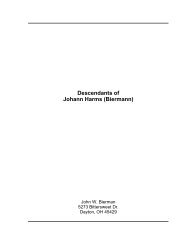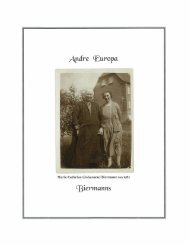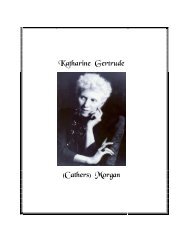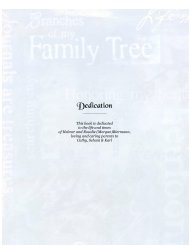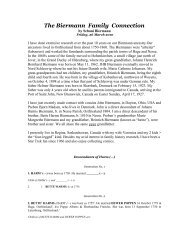A Collection of Dad's Essay's & Writings - Welcome
A Collection of Dad's Essay's & Writings - Welcome
A Collection of Dad's Essay's & Writings - Welcome
Create successful ePaper yourself
Turn your PDF publications into a flip-book with our unique Google optimized e-Paper software.
- Almost Forgotten Ballads Have an Interesting History -<br />
usical history combines so many different styles <strong>of</strong> the art with symphony, opera, operettas art song,<br />
chamber music and solo piano pieces among the prominent works that attract the attention <strong>of</strong> music<br />
lovers. The art songs <strong>of</strong> several countries are <strong>of</strong>fered by recitalists and the vast quantity <strong>of</strong> German<br />
lieder has become staple material for singers. Changing tastes though, on both the classical recital<br />
circuit and the pop music scene, have relegated many <strong>of</strong> the once favorite ballads to relative obscurity.<br />
From time to time singers will delve into the ballad repertoire but a number <strong>of</strong> them are seldom heard nowadays.<br />
Some <strong>of</strong> these songs were concert numbers sung by famous singers throughout the past 150 years others were tunes<br />
that even made the hit parade. Many have interesting stories behind their creation or are associated with interesting<br />
events or notable films.<br />
Still popular and widely heard are the Italian songs that have been belted out by great tenors from Caruso and<br />
Gigli to Domingo, Carreras and Pavarotti. The three tenors have been heard on television in solos, duets and trios<br />
with a fairly extensive repertoire. Of course the popular Irish ballads are still sung on St. Patrick's Day. They have<br />
been kept before the public by Irish tenors from the great John McCormack in past decades and to this day by such<br />
fine singers as the late Frank Patterson and most recently by The Three Irish Tenors heard on PBS.<br />
But somewhere in recent decades the interest in American and British ballads that were written in the last half <strong>of</strong><br />
the nineteenth century and the first 50 years <strong>of</strong> the 20th century have faded from the scene. There are still recordings<br />
available <strong>of</strong> many <strong>of</strong> these ballades but their exposure is not widespread.<br />
It is rather surprising that American composer, Louis Campbell-Tipton's name is seldom found on recitalists'<br />
programs. His composition, “The Spirit Flower”, has more than once been called “striking” by musicologists. Yet the<br />
only prominent exposure this remarkable song received was when Swedish tenor, Jussi Bjorling recorded it many<br />
decades ago. Campbell-Tipton was born in Chicago in 1877, lived in Paris for a number <strong>of</strong> years (where he died) and<br />
composed a number <strong>of</strong> piano selections, popular on the continent.<br />
Once in a while someone discovers Caruso's own ballad “Dreams <strong>of</strong> Long Ago”, which he recorded himself years<br />
before the advent <strong>of</strong> electrical recording. This disc demonstrates his rather unique pronunciation <strong>of</strong> certain English<br />
words, but more importantly the beauty <strong>of</strong> the music he wrote for them is very much in evidence. Caruso was not only<br />
a famous singer, but also a composer and a cartoonist.<br />
A few years ago, baritone Benjamin Luxon brought out a fine collection <strong>of</strong> Victorian Ballads that included the<br />
marvelous “Asleep in the Deep” by American composer, Henry Petrie (1857-1925) which <strong>of</strong>fers the singer an<br />
opportunity to show the depth <strong>of</strong> his voice. But Luxon also <strong>of</strong>fered a stunning version <strong>of</strong> “Wreck <strong>of</strong> the Hesperus”, a<br />
Longfellow poem set to music by John Hatton, who is perhaps better known for his hymn, "I Know That My<br />
Redeemer Lives”, with the tune name “Duke Street”. There is also a fine rendition by Luxon <strong>of</strong> “Break News to<br />
Mother”, a song composed in 1897 just before the Spanish American War by Charles K. Harris.<br />
Another outstanding American composition came from the pen <strong>of</strong> Paul Dresser, born in Terre Haute, Indiana<br />
and considered a master <strong>of</strong> the sentimental ballad in the 1890’s. He was born in 1857 and died in 1916. He composed<br />
“On the Banks <strong>of</strong> the Wabash” and “My Gal Sal” and both songs were prominent in a romanticized film on his career,<br />
called "My Gal Sal” which came out <strong>of</strong> Hollywood in 1942 featuring Rita Heyworth and Victor Mature. Dresser was<br />
the brother <strong>of</strong> Theodore Dresser, noted author <strong>of</strong> “An American Tragedy”. Dreiser once said he gave his brother Paul<br />
the idea for the song about the Wabash River which flows near Terre Haute.<br />
An American ballad that has its roots in Great Britain and sometimes made the concert hall but now seems to<br />
find little interest is “Little Mohee”. It is a song about an Indian maid and is probably best remembered in renditions<br />
by Burl Ives but was once sung on the stage <strong>of</strong> the Saint John High School by baritone Lansing Hatfield at a<br />
Community Concert. His promising career was cut short less than a decade later through a battle with the bottle and<br />
an early death. He told the audience it was a North Carolina ballad. It certainly was a fine number for any old-time<br />
troubadour and as an encore number at recitals.<br />
Many ballads have stories relating to their creation, but many <strong>of</strong> these tales have been forgotten. Not so in the<br />
case <strong>of</strong> “When you and I were Young, Maggie” by Butterfield with words by a 19th century Ontario school teacher<br />
named George W Johnson. The ballad and its creation was the subject <strong>of</strong> a CBC radio program back in the 1930’s.<br />
Johnson collected some fine poetry in a volume that composer James Austin Butterfield discovered and immortalized<br />
Maggie Clark, whom Johnson married. They later moved to Cleveland where Johnson taught school. The tragedy that<br />
is seldom mentioned is that Maggie died less than a year after they were married. Among nostalgic songs, "When you<br />
and I were Young, Maggie” would top the list.<br />
Decades ago, Kenny Baker, backed by an orchestra directed by David Broekman, gave a stunning rendition <strong>of</strong><br />
“Bells <strong>of</strong> St. Mary's”, probably the finest put to disc. At one time Broekman <strong>of</strong>ten directed his orchestra in<br />
arrangements by Saint John native Harold Friars who later gained international fame as music arranger for the show,<br />
“Stop the Music” as well as arranging for well-known radio and recording artists. Baker was part <strong>of</strong> the Jack Benny<br />
show on radio back in the 1930’s and later joined the D'Oyly Carte Company in a filmed version <strong>of</strong> Gilbert and<br />
Sullivan's, “Mikado”. It was the popularity <strong>of</strong> Baker in those years that prompted the movie maker to cast Baker<br />
instead <strong>of</strong> the regular D'Oyly Carte tenor.<br />
One honored American black composer wrote the lovely “Carry Me Back to Old Virginia” which became the<br />
<strong>of</strong>ficial state song <strong>of</strong> Virginia in 1940. In a memorable scene from the Hollywood film, "Maytime," it was sung by<br />
Jeannette MacDonald and Nelson Eddy, portraying American expatriates in Paris. The song was written in 1878 and<br />
was also a favorite concert number <strong>of</strong> Metropolitan Opera star, Grace Moore. Moore, who died in a plane crash at



